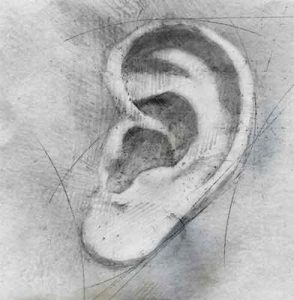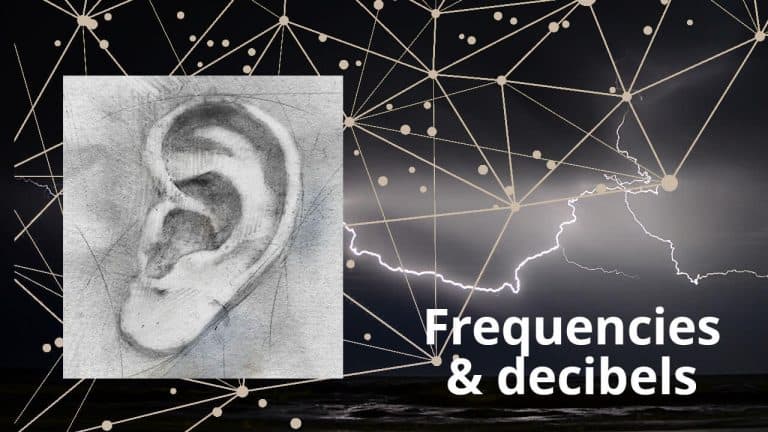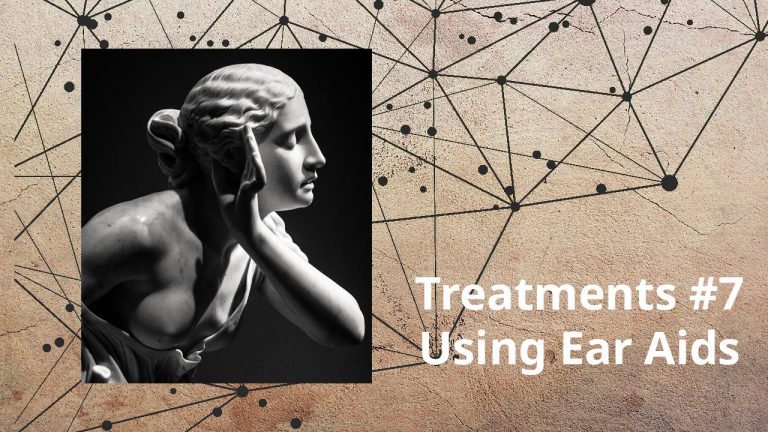Frequencies and Decibels
The sounds we hear are the result of the mechanical vibration of the air around us. This vibration propagates through the air in the form of longitudinal waves. Human beings, like many animals, feel this vibration through the sense of hearing, which is located in the ear.
Acoustics is the science that studies sounds, and the two main parameters used to describe it are frequencies and decibels.

Sound height: the frequency.
Let’s check the case of a ‘pure’ or simple sound, that is, made up of a single frequency.
The graphic representation of the sound wave shows a sinusoid that evolves with time on either side of the intensity line 0.
The time elapsed between the beginning and the end of a cycle is called period.
Frequency is defined as the number of periods per second, expressed in Hertz (Hz). So for instance, 100 cycles per second = 100 Hz.
The highest point of the curve gives the maximum intensity, in this case the volume of the sound expressed in decibels (dB).
The sounds we hear on a daily basis are complex because they consist of the sum of many frequencies, each of them having its own intensity.
It is possible to decompose a complex sound into the set of simple frequencies that compose it by a mathematical process called Fourier Transform.
Classification of frequencies:
Depending on their frequency, sounds are classified into several categories:
Below 120 Hz: low frequency.
120 to 4000 Hz: midrange.
From 4000 to 25000 Hz: treble
Above 25000 Hz: ultrasonic.
What about the human ear?
If the human ear is in theory supposed to perceive frequencies between 20 Hz and 20 000 Hz, in reality the experiment shows that there are great differences between individuals.
When the age increases, the perception of acute frequencies decreases, we speak of aging of the ear.
But even for a young ear, the maximum audible frequency is variable, between 8,000 and over 20,000 Hz.
The standardization of high fidelity devices has chosen to be limited to a standard bandwidth of 20 to 20 000 Hz.
Some animals have much higher hearing abilities than humans. Dogs, for example, perceive ultrasound up to about 45000Hz.
More about the human ear here.
Musical notes, octave and semitones
Let’s take the example of the A4 note, which corresponds to a frequency of 440 Hz.
The musical scale defined a mathematical relationship between frequencies. Thus the A3 corresponds to 220 Hz (440/ 2) and the A5 corresponds to 880 Hz (440 * 2). This difference between two consecutive A notes is called an octave.
An octave is divided into 12 semitones, which correspond to the white and black keys of the piano.
Fundamental and harmonic frequency.
Let’s take a unique note played on the keyboard of a piano.
Let’s choose the A4 key which corresponds to a frequency of 440 Hz. This frequency is called the fundamental of the note.
A note played on an instrument, as here the A4, is complex and composed of many frequencies that combine to give the sound we hear.
The integer multiples of the fundamental are called harmonics. In our example, 880 Hz, 1320 Hz, 2200 Hz are harmonics of the A4 note.
It is the sum of the fundamental and the added harmonic frequencies that produces the characteristic sound of the piano called its timbre.
Each instrument has its own timbre.

Volume of sound: the Decibel
The decibel (dB) is the unit used to measure the volume of a sound, which corresponds to the amplitude of our pure wave seen above.
Adopted in the 1920s in the United States, this unit owes its name to Bell Laboratories and their founder.
The scale is logarithmic, which means concretely that when the sound power is multiplied by 2, the level increases by 3 dB.
When the sound power is multiplied by 10, the level increases by 10 dB.
For example, a sound measured at 43 dB will be perceived as twice as loud as the same sound measured at 40 dB.
Another example: two separate noises added together, of a volume of 50 dB each will give together 53 dB and not 100.
The dB is obtained by a relatively complex mathematical calculation, and is also available in several versions:
• The dB is a ‘theoretical’ sound level which only makes sense at a given frequency.
• The dBA is weighted to account for the peculiarities of the human ear. Indeed, the human ear is more sensitive to high frequencies than to low frequencies. The dB(A) better represents the overall sound level actually perceived by the ear.
• The dB FS (Full Scale) is used in digital audio. To simplify things, it comes in two versions.
• The dB HL (Hearing Level) is specially adapted to the definition of standard audiogram curves.
• There are still other variants, which are used depending on the areas of application.
Audiometry and audiometry test.
Audiometry is an industry that belongs to the field of audiology. This science brings together all the methods, techniques and means necessary to measure the functional state of the pathways of hearing.
To determine the limits of ear perception, an audiometric test must be performed. This test determines which frequencies (in herz) we hear and below which intensity (in dB) we no longer perceive them.
It therefore makes it possible to quantify hearing loss.
To perform the test, an audiometer is used, which generates frequencies at different intensities. For a given frequency, the operator will gradually decrease the intensity until you no longer hear anything. This determines your hearing threshold for the frequency, which will be represented by a point on the audiogram.
The result obtained for all frequencies tested is the audiometric or audiogram curve.
The audiogram is therefore a graphic representation of your hearing ability.
The test is performed separately for each ear
Audiometric testing neglects the ends of the frequency band, limited to testing the band between 125 and 8000 Hz.
The different levels of hearing loss.
• Mild hearing loss – 20 to 40 dB loss:
inability to hear weak sounds, difficulty understanding in noisy environments.
• Average hearing loss – 40-70 dB:
inability to hear weak and moderately loud sounds, great difficulty in understanding speech, especially in noisy environments.
• Severe hearing loss – 70-90 dB:
Need for hearing aid, even if some loud sounds remain audible
• Deep hearing loss – 90 dB or more.




